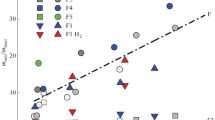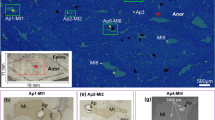Abstract
The solubility of synthetic, pure rare earth phosphates with monazite or xenotime structure (LaPO4 to LuPO4) in hydrous haplogranitic melts was measured at 2 kbar and 800–1,100 °C. Experiments were run for up to 2 months to attain equilibrium. Monazite and xenotime solubility decreases with increasing phosphorus concentration in the melt. Published equations for monazite solubility in felsic melts, which do not explicitly include phosphorus concentration in the melt, should therefore be treated with caution. The effect of phosphorus can be quantitatively modeled if one assumes that monazite partially dissolves as ionic and molecular species in the melt (REE3+ and REEPO4). Equilibrium constants for the dissolution reactions as well as quantitative data on speciation were derived from the solubility data. Monazite and xenotime solubility strongly increases with the peralkalinity of the melt. This effect is mostly due to an increase in the solubility of the ionic species, which are probably stabilized by non-bridging oxygen atoms in the melt. In peraluminous melts, the solubility of monazite and xenotime is nearly constant. Fluorine has no major effect on monazite and xenotime solubility; in fact, the solubility appears to slightly decrease with increasing fluorine content. The solubility of rare earth phosphates is not a simple continuous function of atomic number or ionic radius. Rather, the solubility shows a “tetrad”-like pattern with several local maxima of solubility at individual rare earth elements. The solubilities of neighboring rare earth elements sometimes differ by more than a factor of two; these effects are far outside any analytical error. The tetrad pattern is particularly clearly seen in some of the peralkaline melts and in the fluorine-rich metaluminous melts. Some features, however, such as a solubility maximum at ytterbium, are seen in virtually all melts. The lanthanide tetrad effect in some highly evolved granites may therefore be a result of monazite and xenotime fractionation. The solubility of monazite and xenotime in silicate melt probably shows the tetrad effect, because of the very unusual coordination of the rare earth elements in these phosphate minerals, which is different from the coordination of the melt and therefore causes different crystal field interactions with the partially filled f orbitals of the rare earths. The tetrad effect in granites cannot be used as an indicator of fluid/rock or fluid/melt interaction, since it can be experimentally reproduced in the absence of any fluids.










Similar content being viewed by others
References
Andújar J, Costa F, Martí J (2010) Magma storage conditions of the last eruption of Teide volcano (Canary Islands, Spain). Bull Volcanol 72:381–395
Bau M (1996) Controls on the fractionation of isovalent trace elements in magmatic and aqueous systems: evidence from Y/Ho, Zr/Hf, and lanthanide tetrad effect. Contrib Mineral Petrol 123:323–333
Berndt J, Liebske C, Holtz F, Freise M, Nowak M, Ziegenbein D, Hurkuck W, Koepke J (2002) A combined rapid-quench and H2-membrane setup for internally heated pressure vessels: description and application for water solubility in basaltic melts. Am Mineral 87:1717–1726
Boatner LA (2002) Synthesis, structure, and properties of monazite, pretulite, and xenotime. Rev Mineral Geochem 48:87–121
Breiter K, Förster HJ, Skoda R (2006) Extreme P-, Bi-, Nb-, Sc-, U- and F-rich zircon from fractionated perphosphorous granites: the peraluminous Podlesi granite system, Czech Republic. Lithos 88:15–34
Burnham AD, Berry AJ (2014) The effect of oxygen fugacity, melt composition, temperature and pressure on the oxidation state of cerium in silicate melts. Chem Geol 366:52–60
Burns RG (1993) Mineralogical applications of crystal field theory. Cambridge University Press, Cambridge
Chakhmouradian AR, Wall F (2012) Rare earth elements: minerals, mines, magnets (and more). Elements 8:333–340
Chakhmouradian AR, Zaitsev AN (2012) Rare earth mineralization in igneous rocks: sources and processes. Elements 8:347–353
Cicconi RM, Giuli G, Paris E, Ertel-Ingrisch W, Ulmer P, Dingwell DB (2012) Europium oxidation state and local structure in silicate glasses. Am Mineral 97:918–929
Drake MJ, Weill DF (1972) New rare earth element standards for electron microprobe analysis. Chem Geol 10:179–181
Duc-Tin Q (2007) Experimental studies on the behavior of rare earth elements and tin in granitic systems. PhD thesis, University of Tübingen. https://publikationen.uni-tuebingen.de/xmlui/handle/10900/49059
Förster HJ (1998) The chemical composition of REE–Y–Th–U-rich accessory minerals in peraluminous granites of the Erzgebirge–Fichtelgebirge region, Germany, Part I: the monazite-(Ce)–brabantite solid solution series. Am Mineral 83:259–272
Green TH, Blundy JD, Adam J, Yaxley GM (2000) SIMS determination of trace element partition coefficients between garnet, clinopyroxene and hydrous basaltic liquids at 2–7.5 GPa and 1080–1200°C. Lithos 53:165–187
Harrison TM, Catlos EJ, Montel JM (2002) U–Th–Pb dating of phosphate minerals. Rev Mineral Geochem 48:523–558
Hawthorne FC, Ferguson RB (1975) Refinement of the crystal structure of cryolite. Can Mineral 13:377–382
Hermann J, Rubatto D (2009) Accessory phase control on the trace element signature of sediment melts in subduction zones. Chem Geol 265:512–526
Inoue M, Nakamura N, Kimura M (2009) Tetrad effects in REE abundance patterns of chondrules from CM meteorites: implications for aqueous alteration on the CM parent asteroid. Geochim Cosmochim Acta 73:5224–5239
Irber W (1999) The lanthanide tetrad effect and its correlation with K/Rb, Eu/Eu*, Sr/Eu, Y/Ho, and Zr/Hf of evolving peraluminous granite suites. Geochim Cosmochim Acta 63:489–508
Jahn S (1994) Alteration processes and related shift of elements: the albite granite of Abu Dabbab, Egypt. Eur J Mineral Beih 1:124
Jahn BM, Wu F, Capdevila R, Martineau F, Zhao Z, Wang Y (2001) Highly evolved juvenile granites with tetrad REE patterns: the Woduhe and Baerzhe granites from the Great Xing´an Mountains in NE China. Lithos 59:171–198
Kagi H, Dohmoto Y, Takano S, Masuda A (1993) Tetrad effect in lanthanide partitioning between calcium sulfate crystal and its saturated solution. Chem Geol 107:71–82
Kawabe I (1995) Tetrad effects and fine structures of REE abundance patterns of granitic and rhyolitic rocks: ICP-AES determinations of REE and Y in eight GSJ reference rocks. Geochem J 29:213–230
Kawabe I, Masuda A (2001) The original examples of lanthanide tetrad effect in solvent extraction: a new interpretation compatible with recent progress in REE geochemistry. Geochem J 35:215–224
Keppler H (1993) Influence of fluorine on the enrichment of high field strength trace elements in granitic rocks. Contrib Mineral Petrol 114:479–488
Kirfel A, Will G (1980) Charge density in anhydrite, CaSO4, from X-ray and neutron diffraction measurements. Acta Crystallogr B 36:2881–2890
Liu CQ, Zhang H (2005) The lanthanide tetrad effect in apatite from the Altay No. 3 pegmatite, Xingjiang, China: an intrinsic feature of the pegmatite magma. Chem Geol 214:61–77
Masau M, Cerny P, Chapman R (2000) Dysprosian xenotime-(Y) from the Annie Claim #3 granitic pegmatite, southeastern Manitoba, Canada: evidence of the tetrad effect? Can Mineral 38:899–905
Masuda A, Akagi T (1989) Lanthanide tetrad effect observed in leucogranites from China. Geochem J 23:245–253
McFarlane CRM, Harrison TM (2006) Pb-diffusion in monazite: constraints from a high-T contact aureole setting. Earth Planet Sci Lett 250:376–384
McLennan SM (1994) Rare earth element geochemistry and the “tetrad” effect. Geochim Cosmochim Acta 58:2025–2033
Miller and Mittlefehldt (1982) Depletion of light rare-earth elements in felsic magmas. Geology 10:129–133
Mohamed FH (1993) Rare metal-bearing and barren granites, Eastern Desert of Egypt: geochemical characterization and metallogenetic aspects. J Afr Earth Sci 17:525–539
Monecke T, Dulski P, Kempe U (2007) Origin of convex tetrads in rare earth element patterns of hydrothermally altered siliceous igneous rocks from the Zinnwald Sn–W deposit, Germany. Geochim Cosmochim Acta 71:335–353
Montel JM (1986) Experimental-determination of the solubility of Ce-monazite in SiO2–Al2O3–K2O–Na2O melts at 800 °C, 2 kbar, under H2O-saturated conditions. Geology 14:659–662
Montel JM (1993) A model for monazite/melt equilibrium and application to the generation of granitic magmas. Chem Geol 110:127–146
Ni YX, Hughes JM, Mariano AN (1995) Crystal chemistry of the monazite and xenotime structures. Am Mineral 80:21–26
Nowak M, Behrens H (1995) The speciation of water in haplogranitic glasses and melts determined by in situ near-infrared spectroscopy. Geochim Cosmochim Acta 59:3445–3450
Nugent LJ (1970) Theory of the tetrad effect in the lanthanide (III) and actinide (III) series. J Inorg Nucl Chem 32:3485–3491
Peppard DF, Mason GW, Lewey S (1969) A tetrad effect in the liquid–liquid extraction ordering of lanthanides (III). J Inorg Nucl Chem 31:2271–2272
Pichavant M, Monel JM, Richard LR (1992) Apatite solubility in peraluminous liquids: experimental data and an extension of the Harrison–Watson model. Geochim Cosmochim Acta 56:3855–3861
Plank T, Cooper LB, Manning CE (2009) Emerging geothermometers for estimating slab surface temperatures. Nat Geosci 2:611–615
Ponader CW, Brown GE (1989) Rare-earth elements in silicate glass melt systems. 1. Effects of composition on the coordination environments of La, Gd, and Yb. Geochim Cosmochim Acta 53:2893–2903
Rapp RP, Watson EB (1986) Monazite solubility and dissolution kinetics: implications for the thorium and light rare earth chemistry of felsic magmas. Contrib Mineral Petrol 94:304–316
Schaller T, Dingwell DB, Keppler H, Knoller W, Merwin L, Sebald A (1992) Fluorine in silicate glasses—a multinuclear nuclear magnetic resonance study. Geochim Cosmochim Acta 56:701–707
Skora S, Blundy J (2012) Monazite solubility in hydrous silicic melts at high pressure conditions relevant to subduction zone metamorphism. Earth Planet Sci Lett 321–322:104–114
Stepanov AS, Herrmann J, Rubatto D, Rapp RP (2012) Experimental study of monazite/melt partitioning with implications for the REE, Th and U geochemistry of crystal rocks. Chem Geol 300–301:200–220
Veksler IV, Dorfman AM, Kamenetsky M, Dulski P, Dingwell DB (2005) Partitioning of lanthanides and Y between immiscible silicate and fluoride melts, fluorite and cryolite and the origin of the lanthanide tetrad effect in igneous rocks. Geochim Cosmochim Acta 69:2847–2860
Wolf MB, London D (1995) Incongruent dissolution of REE-rich and Sr-rich apatite in peraluminous granitic liquids—differential apatite, monazite, and xenotime solubilities during anatexis. Am Mineral 80:765–775
Xing L, Trail D, Watson BE (2013) Th and U partitioning between monazite and felsic melt. Chem Geol 358:46–53
Yurimoto H, Duke EF, Papike JJ, Shearer CK (1990) Are discontinuous chondrite-normalized REE patterns in pegmatitic granite systems the result of monazite fractionation? Geochim Cosmochim Acta 54:2141–2145
Acknowledgments
We thank Thomas Wenzel (Tübingen) for his great help with the microprobe analyses. Tiziana Boffa Ballaran kindly provided the drawings of the cation sites in minerals. Constructive reviews by Arnauld Villaros and an anonymous referee improved the manuscript. This study was supported by German Science Foundation (DFG; Leibniz award to HK) and by the German Academic Exchange Service (DAAD; fellowship to QDT).
Author information
Authors and Affiliations
Corresponding author
Additional information
Communicated by Jochen Hoefs.
Electronic supplementary material
Below is the link to the electronic supplementary material.
Rights and permissions
About this article
Cite this article
Duc-Tin, Q., Keppler, H. Monazite and xenotime solubility in granitic melts and the origin of the lanthanide tetrad effect. Contrib Mineral Petrol 169, 8 (2015). https://doi.org/10.1007/s00410-014-1100-9
Received:
Accepted:
Published:
DOI: https://doi.org/10.1007/s00410-014-1100-9




